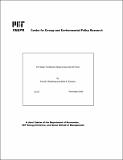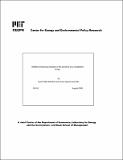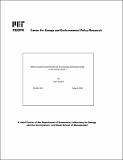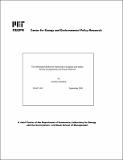Browsing Working Papers by Title
Now showing items 322-334 of 334
-
The Weak Tie Between Natural Gas and Oil Prices
(MIT Center for Energy and Environmental Policy Research, 2010-11)Several recent studies establish that crude oil and natural gas prices are cointegrated, so that changes in the price of oil appear to translate into changes in the price of natural gas. Yet at times in the past, and very ... -
Welfare-enhancing collusion in the presence of a competitive fringe
(MIT Center for Energy and Environmental Policy Research, 2005)Following the structure of many commodity markets, we consider a reduced number of large firms and a competitive fringe of many small suppliers choosing quantities in an infinitehorizon setting subject to demand shocks. ... -
What does a negawatt really cost?
(MIT Center for Energy and Environmental Policy Research, 1991)We use data from ten utility conservation programs to calculate the cost per kWh of electricity saved -- the cost of a "negawatthour" -- resulting from these programs. We first compute the life-cycle cost per kWh saved ... -
What does a negawatt really cost? : further thoughts and evidence
(MIT Center for Energy and Environmental Policy Research, 1993) -
What should the government do to encourage technical change in the energy sector?
(MIT Center for Energy and Environmental Policy Research, 2005)Government support of innovation - both technology creation and technology demonstration - is desirable to encourage private investors to adopt new technology. In this paper, I review the government role in encouraging ... -
The wholesale market for electricity in England and Wales : recent developments and future reforms
(MIT Center for Energy and Environmental Policy Research, 2000)The England and Wales wholesale electricity market is about to undergo major reform (NETA). I describe and analyse the proposed arrangements, contrasting them with those currently in operation. I argue that while NETA will ... -
Why and How the European Union Can Get a (Near To) Carbon-Free Energy System in 2050?
(MIT Center for Energy and Environmental Research Policy, 2010-03)Reducing the European Union GHG emissions by at least 80% by 2050 will require a near zero carbon electricity, road and rail transport industry, and heating and cooling in buildings. As compared to “business as usual” the ... -
Why are allowance prices so low? : an analysis of the SO2 emissions trading program
(MIT Center for Energy and Environmental Policy Research, 1996)This paper presents an analysis of the reduction in SO2 emissions by electric utilities between 1985 and 1993. We find that emissions have been reduced for reasons largely unrelated to the emission reduction mandate ... -
Why did British electricity prices fall after 1998?
(MIT Center for Energy and Environmental Policy Research, 2003)In an attempt to reduce high electricity prices in England and Wales the government has reduced concentration among generators and introduced New Electricity Trading Arrangements (NETA). Econometric analysis on monthly ... -
Why do we need electricity retailers?; or, can you get it cheaper wholesale?
(MIT Center for Energy and Environmental Policy Research, 2000)The opportunities for retail electricity competition to provide new value-added services to retail electricity consumers are discussed. The physical attributes of electricity supply make many of the traditional "convenience ... -
World energy consumption and carbon dioxide emissions : 1950-2050
(MIT Center for Energy and Environmental Policy Research, 1995)Emissions of carbon dioxide form combustion of fossil fuels, which may contribute to long-term climate change, are projected through 2050 using reduced form models estimated with national-level panel data for the period ... -
World Oil: Market or Mayhem?
(2008)The world oil market is regarded by many as a puzzle. Why are oil prices so volatile? What is OPEC and what does OPEC do? Where are oil prices headed in the long run? Is “peak oil” a genuine concern? Why did oil prices ... -
The world price of coal
(MIT Center for Energy and Environmental Policy Research, 1994)A significant increase in the seaborne trade for coal over the past twenty years has unified formerly separate coal markets into a world market in which prices move in tandem. Due to its large domestic market, the United ...












